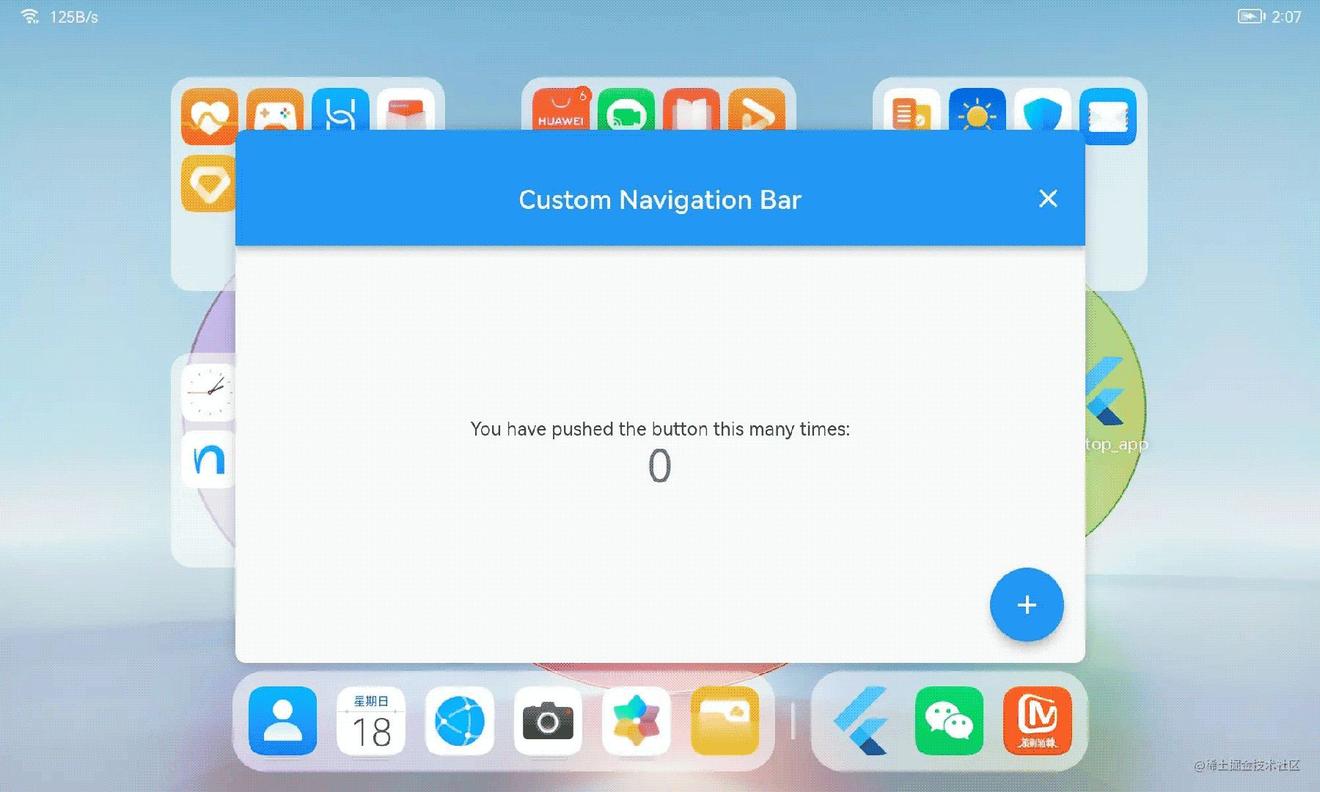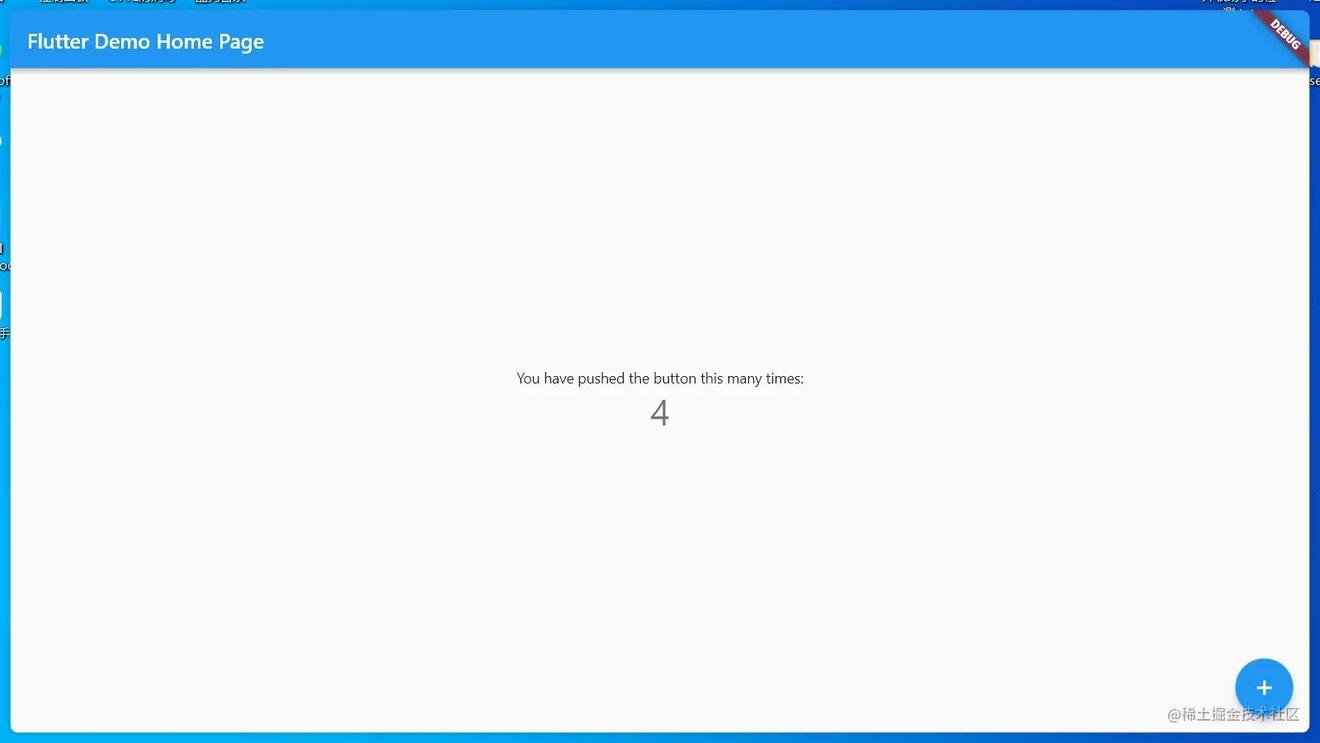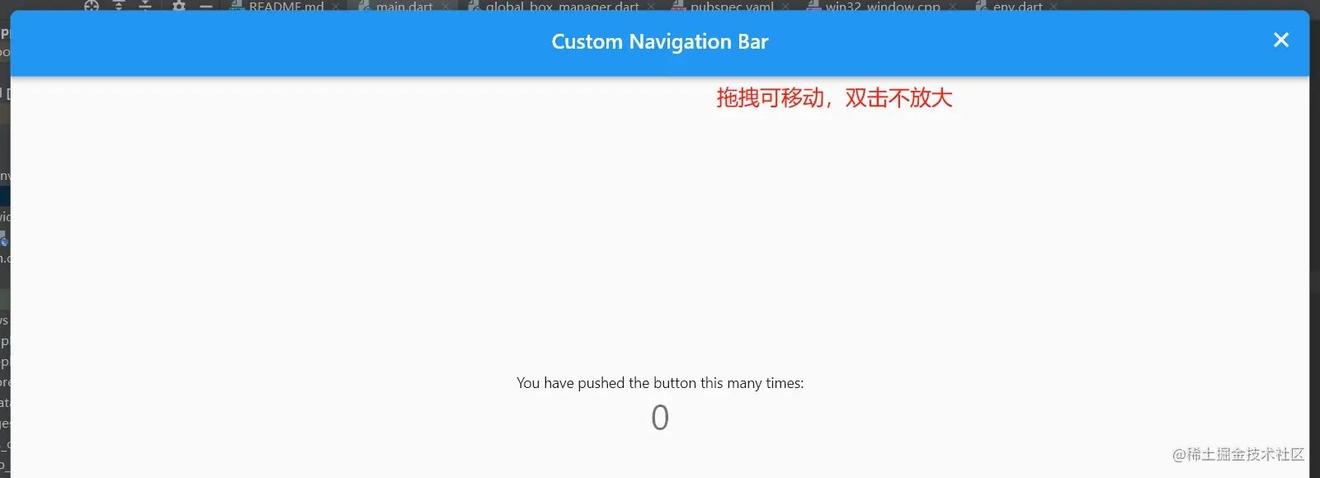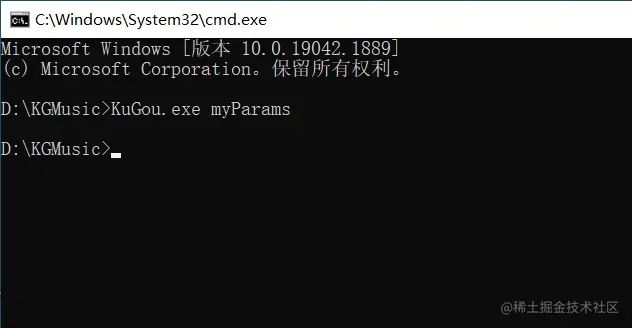目录
- 前言
- 一、应用窗口的常规配置
- 应用窗口化
- 自定义窗口导航栏
- 美化应用窗口
- 二、windows平台特定交互
- 注册表操作
- 执行控制台指令
- 实现应用单例
- 三、桌面应用的交互习惯
- 按钮点击态
- 获取应用启动参数
- 四、写在最后
前言
通过此篇文章,你可以编写出一个完整桌面应用的窗口框架。
你将了解到:
- Flutter在开发windows和Android桌面应用初始阶段,应用窗口的常规配置;
- windows平台特定交互的实现,如:执行控制台指令,windows注册表,应用单例等;
- 桌面应用的交互习惯,如:交互点击态,不同大小的页面切换,获取系统唤起应用的参数等。
在使用Flutter开发桌面应用之前,笔者之前都是开发移动App的,对于移动应用的交互比较熟悉。开始桌面应用开发后,我发现除了技术栈一样之外,其他交互细节、用户行为习惯以及操作系统特性等都有很大的不同。
我将在windows和android桌面设备上,从0到1亲自搭建一个开源项目,并且记录实现细节和技术难点。
一、应用窗口的常规配置
众所周知,Flutter目前最大的应用是在移动app上,在移动设备上都是以全屏方式展示,因此没有应用窗口这个概念。而桌面应用是窗口化的,需求方一般都会对窗口外观有很高的要求,比如:自定义窗口导航栏、设置圆角、阴影;同时还有可能要禁止系统自动放大的行为。
应用窗口化
Flutter在windows桌面平台,是依托于Win32Window承载engine的,而Win32Windows本身就是窗口化的,无需再做过多的配置。(不过也正因为依托原生窗口,作为UI框架的flutter完全没办法对Win32Window的外观做任何配置)
| // win32_window.cpp | |
| bool Win32Window::CreateAndShow(const std::wstring& title, | |
| const Point& origin, | |
| const Size& size) { | |
| // ...此处省略代码... | |
| // 这里创建了win32接口的句柄 | |
| HWND window = CreateWindow( | |
| window_class, title.c_str(), WS_POPUP | WS_SYSMENU | WS_MINIMIZEBOX | WS_MAXIMIZEBOX, | |
| Scale(origin.x, scale_factor), Scale(origin.y, scale_factor), | |
| Scale(size.width, scale_factor), Scale(size.height, scale_factor), | |
| nullptr, nullptr, GetModuleHandle(nullptr), this); | |
| UpdateWindow(window); | |
| if (!window) { | |
| return false; | |
| } | |
| return OnCreate(); | |
| } | |
| bool FlutterWindow::OnCreate() { | |
| if (!Win32Window::OnCreate()) { | |
| return false; | |
| } | |
| // GetClientArea获取创建的win32Window区域 | |
| RECT frame = GetClientArea(); | |
| // 绑定窗口和flutter engine | |
| flutter_controller_ = std::make_unique<flutter::FlutterViewController>( | |
| frame.right - frame.left, frame.bottom - frame.top, project_); | |
| if (!flutter_controller_->engine() || !flutter_controller_->view()) { | |
| return false; | |
| } | |
| RegisterPlugins(flutter_controller_->engine()); | |
| SetChildContent(flutter_controller_->view()->GetNativeWindow()); | |
| return true; | |
| } |
应用窗口化主要是针对Android平台,Flutter应用是依托于Activity的,Android平台上Activity默认是全屏,且出于安全考虑,当一个Activity展示的时候,是不允许用户穿透点击的。所以想要让Flutter应用在Android大屏桌面设备上展示出windows上的效果,需要以下步骤:
- 将底层承载的FlutterActivity的主题样式设置为Dialog,同时全屏窗口的背景色设置为透明,点击时Dialog不消失;
| <!-- android/app/src/main/res/values/styles.xml --> | |
| <style name="Theme.DialogApp" parent="Theme.AppCompat.Light.Dialog"> | |
| <item name="android:windowBackground">@drawable/launch_application</item> | |
| <item name="android:windowIsTranslucent">true</item> | |
| <item name="android:windowContentOverlay">@null</item> | |
| <item name="android:backgroundDimEnabled">false</item> | |
| <item name="windowActionBar">false</item> | |
| <item name="windowNoTitle">true</item> | |
| </style> | |
| <!-- android/app/src/main/AndroidManifest.xml --> | |
| <activity | |
| android:name=".MainActivity" | |
| android:exported="true" | |
| android:hardwareAccelerated="true" | |
| android:launchMode="singleTop" | |
| android:theme="@style/Theme.DialogApp" | |
| android:windowSoftInputMode="adjustResize"> | |
| <meta-data | |
| android:name="io.flutter.embedding.android.NormalTheme" | |
| android:resource="@style/Theme.DialogApp" /> | |
| <intent-filter> | |
| <action android:name="android.intent.action.MAIN" /> | |
| <category android:name="android.intent.category.LAUNCHER" /> | |
| </intent-filter> | |
| </activity> | |
| // android/app/src/main/kotlin/com/maxhub/upgrade_assistant/MainActivity.kt | |
| class MainActivity : FlutterActivity() { | |
| override fun getTransparencyMode(): TransparencyMode { | |
| // 设置窗口背景透明 | |
| return TransparencyMode.transparent | |
| } | |
| override fun onResume() { | |
| super.onResume() | |
| setFinishOnTouchOutside(false) // 点击外部,dialog不消失 | |
| // 设置窗口全屏 | |
| var lp = window.attributes | |
| lp.width = -1 | |
| lp.height = -1 | |
| window.attributes = lp | |
| } | |
| } |
- 至此Android提供了一个全屏的透明窗口,Flutter runApp的时候,我在MaterialApp外层套了一个盒子控件,这个控件内部主要做边距、阴影等一系列窗口化行为。
| class GlobalBoxManager extends StatelessWidget { | |
| GlobalBoxManager({Key? key, required this.child}) : super(key: key); | |
| final Widget child; | |
| @override | |
| Widget build(BuildContext context) { | |
| return Container( | |
| width: ScreenUtil().screenWidth, | |
| height: ScreenUtil().screenHeight, | |
| // android伪全屏,加入边距 | |
| padding: EdgeInsets.symmetric(horizontal: 374.w, vertical: 173.h), | |
| child: child, | |
| ); | |
| } | |
| } | |
| // MyApp下的build构造方法 | |
| GlobalBoxManager( | |
| child: GetMaterialApp( | |
| locale: Get.deviceLocale, | |
| translations: Internationalization(), | |
| // 桌面应用的页面跳转习惯是无动画的,符合用户习惯 | |
| defaultTransition: Transition.noTransition, | |
| transitionDuration: Duration.zero, | |
| theme: lightTheme, | |
| darkTheme: darkTheme, | |
| initialRoute: initialRoute, | |
| getPages: RouteConfig.getPages, | |
| title: 'appName'.tr, | |
| ), | |
| ), |
- 效果图

自定义窗口导航栏
主要针对Windows平台,原因上面我们解析过:win32Window是在windows目录下的模板代码创建的默认是带系统导航栏的(如下图)。

很遗憾Flutter官方也没有提供方法,pub库上对窗口操作支持的最好的是window_manager,由国内Flutter桌面开源社区leanFlutter所提供。
- yaml导入window_manager,在runApp之前执行以下代码,把win32窗口的导航栏去掉,同时配置背景色为透明、居中显示;
| dependencies: | |
| flutter: | |
| sdk: flutter | |
| window_manager: ^0.2.6 | |
| // runApp之前运行 | |
| WindowManager w = WindowManager.instance; | |
| await w.ensureInitialized(); | |
| WindowOptions windowOptions = WindowOptions( | |
| size: normalWindowSize, | |
| center: true, | |
| titleBarStyle: TitleBarStyle.hidden // 该属性隐藏导航栏 | |
| ); | |
| w.waitUntilReadyToShow(windowOptions, () async { | |
| await w.setBackgroundColor(Colors.transparent); | |
| await w.show(); | |
| await w.focus(); | |
| await w.setAsFrameless(); | |
| }); |
- 此时会发现应用打开时在左下角闪一下再居中。这是由于原生win32窗口默认是左上角显示,而后在flutter通过插件才居中;
- 处理方式建议在原生代码中先把窗口设为默认不显示,通过上面的window_manager.show()展示出来;
| // windows/runner/win32_window.cpp | |
| HWND window = CreateWindow( | |
| // 去除WS_VISIBLE属性 | |
| window_class, title.c_str(), WS_OVERLAPPEDWINDOW, | |
| Scale(origin.x, scale_factor), Scale(origin.y, scale_factor), | |
| Scale(size.width, scale_factor), Scale(size.height, scale_factor), | |
| nullptr, nullptr, GetModuleHandle(nullptr), this); |
美化应用窗口
通过前面的步骤,我们在android和windows平台上都得到了一个安全透明的窗口,接下来的修饰Flutter就可以为所欲为了。
- 窗口阴影、圆角
上面介绍过在MaterialApp外套有盒子控件,直接在Container内加入阴影和圆角即可,不过Android和桌面平台还是需要区分下的;
| import 'dart:io'; | |
| import 'package:flutter/material.dart'; | |
| class GlobalBoxManager extends StatelessWidget { | |
| const GlobalBoxManager({Key? key, required this.child}) : super(key: key); | |
| final Widget child; | |
| @override | |
| Widget build(BuildContext context) { | |
| return Container( | |
| width: double.infinity, | |
| height: double.infinity, | |
| // android伪全屏,加入边距 | |
| padding: Platform.isAndroid | |
| ? const EdgeInsets.symmetric(horizontal: 374, vertical: 173) | |
| : EdgeInsets.zero, | |
| child: Container( | |
| clipBehavior: Clip.antiAliasWithSaveLayer, | |
| margin: const EdgeInsets.all(10), | |
| decoration: const BoxDecoration( | |
| borderRadius: BorderRadius.all(Radius.circular(8)), | |
| boxShadow: [ | |
| BoxShadow(color: Color(0x33000000), blurRadius: 8), | |
| ]), | |
| child: child, | |
| ), | |
| ); | |
| } | |
| } |

- 自定义导航栏
回归Scaffold的AppBar配置,再加上导航拖拽窗口事件(仅windows可拖拽)
| @override | |
| Widget build(BuildContext context) { | |
| return Scaffold( | |
| appBar: PreferredSize( | |
| preferredSize: const Size.fromHeight(64), | |
| child: GestureDetector( | |
| behavior: HitTestBehavior.translucent, | |
| onPanStart: (details) { | |
| if (Platform.isWindows) windowManager.startDragging(); | |
| }, | |
| onDoubleTap: () {}, | |
| child: AppBar( | |
| title: Text(widget.title), | |
| centerTitle: true, | |
| actions: [ | |
| GestureDetector( | |
| behavior: HitTestBehavior.opaque, | |
| child: const Padding( | |
| padding: EdgeInsets.symmetric(horizontal: 16), | |
| child: Icon( | |
| Icons.close, | |
| size: 24, | |
| ), | |
| ), | |
| ), | |
| ], | |
| ), | |
| ), | |
| ), | |
| body: Center(), | |
| ); | |
| } |

到这里多平台的窗口就配置好了,接下来可以愉快的编写页面啦。
可能有些小伙伴会说:窗口的效果本就应该由原生去写,为啥要让Flutter去做这么多的事情?
答案很简单:
跨平台! 要跨平台就势必需要绕一些,通过这种方式你会发现任何平台的应用,都可以得到相同效果的窗口,而代码只需要Flutter写一次,这才是Flutter存在的真正意义。
二、windows平台特定交互
在开发windows的过程中,我发现跟移动app最大的不同在于:桌面应用需要频繁的去与系统做一些交互。
注册表操作
应用开发过程中,经常需要通过注册表来做数据存储;在pub上也有一个库提供这个能力,但是我没有使用,因为dart已经提供了win32相关的接口,我认为这个基础的能力没必要引用多一个库,所以手撸了一个工具类来操作注册表。(值得注意的是部分注册表的操作是需要管理员权限的,所以应用提权要做好)
| import 'dart:ffi'; | |
| import 'package:ffi/ffi.dart'; | |
| import 'package:win32/win32.dart'; | |
| const maxItemLength= 2048; | |
| class RegistryKeyValuePair { | |
| final String key; | |
| final String value; | |
| const RegistryKeyValuePair(this.key, this.value); | |
| } | |
| class RegistryUtil { | |
| /// 根据键名获取注册表的值 | |
| static String? getRegeditForKey(String regPath, String key, | |
| {int hKeyValue = HKEY_LOCAL_MACHINE}) { | |
| var res = getRegedit(regPath, hKeyValue: hKeyValue); | |
| return res[key]; | |
| } | |
| /// 设置注册表值 | |
| static setRegeditValue(String regPath, String key, String value, | |
| {int hKeyValue = HKEY_CURRENT_USER}) { | |
| final phKey = calloc<HANDLE>(); | |
| final lpKeyPath = regPath.toNativeUtf16(); | |
| final lpKey = key.toNativeUtf16(); | |
| final lpValue = value.toNativeUtf16(); | |
| try { | |
| if (RegSetKeyValue(hKeyValue, lpKeyPath, lpKey, REG_SZ, lpValue, | |
| lpValue.length * 2) != | |
| ERROR_SUCCESS) { | |
| throw Exception("Can't set registry key"); | |
| } | |
| return phKey.value; | |
| } finally { | |
| free(phKey); | |
| free(lpKeyPath); | |
| free(lpKey); | |
| free(lpValue); | |
| RegCloseKey(HKEY_CURRENT_USER); | |
| } | |
| } | |
| /// 获取注册表所有子项 | |
| static List<String>? getRegeditKeys(String regPath, | |
| {int hKeyValue = HKEY_LOCAL_MACHINE}) { | |
| final hKey = _getRegistryKeyHandle(hKeyValue, regPath); | |
| var dwIndex = 0; | |
| String? key; | |
| List<String>? keysList; | |
| key = _enumerateKeyList(hKey, dwIndex); | |
| while (key != null) { | |
| keysList ??= []; | |
| keysList.add(key); | |
| dwIndex++; | |
| key = _enumerateKeyList(hKey, dwIndex); | |
| } | |
| RegCloseKey(hKey); | |
| return keysList; | |
| } | |
| /// 删除注册表的子项 | |
| static bool deleteRegistryKey(String regPath, String subPath, | |
| {int hKeyValue = HKEY_LOCAL_MACHINE}) { | |
| final subKeyForPath = subPath.toNativeUtf16(); | |
| final hKey = _getRegistryKeyHandle(hKeyValue, regPath); | |
| try { | |
| final status = RegDeleteKey(hKey, subKeyForPath); | |
| switch (status) { | |
| case ERROR_SUCCESS: | |
| return true; | |
| case ERROR_MORE_DATA: | |
| throw Exception('An item required more than $maxItemLength bytes.'); | |
| case ERROR_NO_MORE_ITEMS: | |
| return false; | |
| default: | |
| throw Exception('unknown error'); | |
| } | |
| } finally { | |
| RegCloseKey(hKey); | |
| free(subKeyForPath); | |
| } | |
| } | |
| /// 根据项的路径获取所有值 | |
| static Map<String, String> getRegedit(String regPath, | |
| {int hKeyValue = HKEY_CURRENT_USER}) { | |
| final hKey = _getRegistryKeyHandle(hKeyValue, regPath); | |
| final Map<String, String> portsList = <String, String>{}; | |
| /// The index of the value to be retrieved. | |
| var dwIndex = 0; | |
| RegistryKeyValuePair? item; | |
| item = _enumerateKey(hKey, dwIndex); | |
| while (item != null) { | |
| portsList[item.key] = item.value; | |
| dwIndex++; | |
| item = _enumerateKey(hKey, dwIndex); | |
| } | |
| RegCloseKey(hKey); | |
| return portsList; | |
| } | |
| static int _getRegistryKeyHandle(int hive, String key) { | |
| final phKey = calloc<HANDLE>(); | |
| final lpKeyPath = key.toNativeUtf16(); | |
| try { | |
| final res = RegOpenKeyEx(hive, lpKeyPath, 0, KEY_READ, phKey); | |
| if (res != ERROR_SUCCESS) { | |
| throw Exception("Can't open registry key"); | |
| } | |
| return phKey.value; | |
| } finally { | |
| free(phKey); | |
| free(lpKeyPath); | |
| } | |
| } | |
| static RegistryKeyValuePair? _enumerateKey(int hKey, int index) { | |
| final lpValueName = wsalloc(MAX_PATH); | |
| final lpcchValueName = calloc<DWORD>()..value = MAX_PATH; | |
| final lpType = calloc<DWORD>(); | |
| final lpData = calloc<BYTE>(maxItemLength); | |
| final lpcbData = calloc<DWORD>()..value = maxItemLength; | |
| try { | |
| final status = RegEnumValue(hKey, index, lpValueName, lpcchValueName, | |
| nullptr, lpType, lpData, lpcbData); | |
| switch (status) { | |
| case ERROR_SUCCESS: | |
| { | |
| // if (lpType.value != REG_SZ) throw Exception('Non-string content.'); | |
| if (lpType.value == REG_DWORD) { | |
| return RegistryKeyValuePair(lpValueName.toDartString(), | |
| lpData.cast<Uint32>().value.toString()); | |
| } | |
| if (lpType.value == REG_SZ) { | |
| return RegistryKeyValuePair(lpValueName.toDartString(), | |
| lpData.cast<Utf16>().toDartString()); | |
| } | |
| break; | |
| } | |
| case ERROR_MORE_DATA: | |
| throw Exception('An item required more than $maxItemLength bytes.'); | |
| case ERROR_NO_MORE_ITEMS: | |
| return null; | |
| default: | |
| throw Exception('unknown error'); | |
| } | |
| } finally { | |
| free(lpValueName); | |
| free(lpcchValueName); | |
| free(lpType); | |
| free(lpData); | |
| free(lpcbData); | |
| } | |
| return null; | |
| } | |
| static String? _enumerateKeyList(int hKey, int index) { | |
| final lpValueName = wsalloc(MAX_PATH); | |
| final lpcchValueName = calloc<DWORD>()..value = MAX_PATH; | |
| try { | |
| final status = RegEnumKeyEx(hKey, index, lpValueName, lpcchValueName, | |
| nullptr, nullptr, nullptr, nullptr); | |
| switch (status) { | |
| case ERROR_SUCCESS: | |
| return lpValueName.toDartString(); | |
| case ERROR_MORE_DATA: | |
| throw Exception('An item required more than $maxItemLength bytes.'); | |
| case ERROR_NO_MORE_ITEMS: | |
| return null; | |
| default: | |
| throw Exception('unknown error'); | |
| } | |
| } finally { | |
| free(lpValueName); | |
| free(lpcchValueName); | |
| } | |
| } | |
| } |
执行控制台指令
windows上,我们可以通过cmd指令做所有事情,dart也提供了这种能力。我们可以通过io库中的Progress类来运行指令。如:帮助用户打开网络连接。
Process.start('ncpa.cpl', [],runInShell: true);
刚接触桌面开发的小伙伴,真的很需要这个知识点。
实现应用单例
应用单例是windows需要特殊处理,android默认是单例的。而windows如果不作处理,每次点击都会重新运行一个应用进程,这显然不合理。Flutter可以通过windows_single_instance插件来实现单例。在runApp之前执行下这个方法,重复点击时会让用户获得焦点置顶,而不是多开一个应用。
| /// windows设置单实例启动 | |
| static setSingleInstance(List<String> args) async { | |
| await WindowsSingleInstance.ensureSingleInstance(args, "desktop_open", | |
| onSecondWindow: (args) async { | |
| // 唤起并聚焦 | |
| if (await windowManager.isMinimized()) await windowManager.restore(); | |
| windowManager.focus(); | |
| }); | |
| } |
三、桌面应用的交互习惯
按钮点击态
按钮点击交互的状态,其实在移动端也存在。但不同的是移动端的按钮基本上水波纹的效果就能满足用户使用,但是桌面应用显示区域大,而点击的鼠标却很小,很多时候点击已经过去但水波纹根本就没显示出来。
正常交互是:点击按钮马上响应点击态的颜色(文本和背景都能编),松开恢复。
| TextButton( | |
| clipBehavior: Clip.antiAliasWithSaveLayer, | |
| style: ButtonStyle( | |
| animationDuration: Duration.zero, // 动画延时设置为0 | |
| visualDensity: VisualDensity.compact, | |
| overlayColor: MaterialStateProperty.all(Colors.transparent), | |
| padding: MaterialStateProperty.all(EdgeInsets.zero), | |
| textStyle: | |
| MaterialStateProperty.all(Theme.of(context).textTheme.subtitle1), | |
| // 按钮按下的时候的前景色,会让文本的颜色按下时变为白色 | |
| foregroundColor: MaterialStateProperty.resolveWith((states) { | |
| return states.contains(MaterialState.pressed) | |
| ? Colors.white | |
| : Theme.of(context).toggleableActiveColor; | |
| }), | |
| // 按钮按下的时候的背景色,会让背景按下时变为蓝色 | |
| backgroundColor: MaterialStateProperty.resolveWith((states) { | |
| return states.contains(MaterialState.pressed) | |
| ? Theme.of(context).toggleableActiveColor | |
| : null; | |
| }), | |
| ), | |
| onPressed: null, | |
| child: XXX), | |
| ) |
获取应用启动参数
由于我们的桌面设备升级自研的整机,因此在开发过程经常遇到其他软件要唤起Flutter应用的需求。那么如何唤起,又如何拿到唤起参数呢?
1. windows:其他应用通过Procress.start启动.exe即可运行Flutter的软件;传参也非常简单,直接.exe后面带参数,多个参数使用空格隔开,然后再Flutter main函数中的args就能拿到参数的列表,非常方便。

其实cmd执行的参数,是被win32Window接收了,只是Flutter帮我们做了这层转换,通过engine传递给main函数,而Android就没那么方便了。
2. Android:Android原生启动应用是通过Intent对应包名下的Activity,然后再Activity中通过Intent.getExtra可以拿到参数。我们都知道Android平台下Flutter只有一个Activity,因此做法是先在MainActivity中拿到Intent的参数,然后建立Method Channel通道;
``` kotlin class MainActivity : FlutterActivity() { private var sharedText: String? = null private val channel = "app.open.shared.data"
| override fun onCreate(savedInstanceState: Bundle?) { | |
| super.onCreate(savedInstanceState) | |
| val intent = intent | |
| handleSendText(intent) // Handle text being sent | |
| } | |
| override fun onRestart() { | |
| super.onRestart() | |
| flutterEngine!!.lifecycleChannel.appIsResumed() | |
| } | |
| override fun configureFlutterEngine(flutterEngine: FlutterEngine) { | |
| super.configureFlutterEngine(flutterEngine) | |
| MethodChannel(flutterEngine.dartExecutor.binaryMessenger, channel) | |
| .setMethodCallHandler { call: MethodCall, result: MethodChannel.Result -> | |
| when (call.method) { | |
| "getSharedText" -> { | |
| result.success(sharedText) | |
| } | |
| } | |
| } | |
| } | |
| private fun handleSendText(intent: Intent) { | |
| sharedText = intent.getStringExtra("params") | |
| } | |
| } | |
| ``` | |
| Flutter层在main函数中通过Method Channel的方式取到MainActivity中存储的参数,绕多了一层链路。 | |
| ```dart | |
| const platform = MethodChannel('app.open.shared.data'); | |
| String? sharedData = await platform.invokeMethod('getSharedText'); | |
| if (sharedData == null) return null; | |
| return jsonDecode(sharedData); | |
| ``` |
四、写在最后
通过上面这么多的实现,我们已经完全把一个应用窗体结构搭建起来了。长篇幅的实战记录,希望可以切实的帮助到大家。总体来说,桌面开发虽然还有很多缺陷,但是能用,性能尚佳,跨平台降低成本。